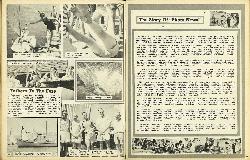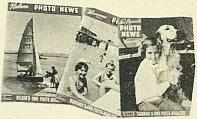29
The Story of "Photo News"
Readers of "Photo News", intrigued by this unique venture into the publishing world, often ask about its origins. The story is a simple one, of an idea developed from its conception, through the trials and tribulations of early development, to the stage of a successful business and an accepted part of community life in several provincial centres.
"Photo News" was conceived with more than the usual amount of trepidation. Its author was a country newspaper-man with photography for a hobby, and a background in the printing industry, but very little else. The idea was tried out in a small way in a country town in the South Island. After six months, the most notable result was that it had reduced the proprietor's capital to almost nothing, A decision had to be made: whether the doubtful economic prospects of such a magazine, plus the very formidable technical problems involved, warranted continuing.
Expert advice was sought, The answer was emphatically and depressingly in the negative. To go on, we were told, would be pig-headed. But the country town experience had proved one important thing: that people would buy such a magazine, provided they lived in a town not so large that it had lost its sense of community.
It was decided to give the venture a further trial. Packing up the tiny press (the first issues were printed on a lithographic press about the size of an office duplicator) and their household belongings, the proprietor and his wife and family set out in search of a more suitable place to establish "Photo News", They selected Gisborne, ojae of the most isolated of cities, which then had a population of about 19, 000, and a newspaper without local illustrations.
The little press was set up in the back room of an old house in Gisborne, along with a homemade process camera, and preparations were made for the first issue. Today, the various processes by which "Photo News" is produced are divided among well-staffed departments, but for that first issue, the magazine was a "one-man band". The hopeful proprietor had to take the pictures, develop the films, enlarge the prints, type the material, process the lot, print down the negatives on lithographic plates, run the press, and work the stapling machine and guillotine. Three thousand copies were printed. Only 9O0 were sold, and it looked like the expert advice had been right.
But the second issue sales went up to 1300, and within a year they were over 3000, Today "Gisborne photo News" sells over 7000 copies a month. New magazines were started in New Plymouth and Wanganui, and in 1960, seven years after it had left the South Island, "Photo News" returned to start publication in Nelson. Three new magazines are now in the planning stage.
Because of the difficult technical problems associated with the work, and the expensive machinery required, it has not been possible to set up printing plants in each of the centres where magazines are published. Instead, plant has been centralised in Gisborne, where the original "back room" has grown into a factory with 3, 500 square feet of space, with two Crabtree presses and modern ancillary equipment, This up-to-date plant now produces 27, 000 magazines a month, all with colour covers, and is capable of handling up to 45,000 magazines a month.
We are not sure what is the most important lesson to be taken from the success of "Photo News", unless it is that "expert advice" is not always right. We like to think that our success is the just reward of hard work and perseverance, but perhaps it was merely the result of refusing to stop being "pig-headed".





